By 2025, the global market for natural language processing (NLP) is expected to reach $43 billion, highlighting its rapid growth and the increasing reliance on AI-driven language technologies. It is a dynamic subfield of artificial intelligence that bridges the communication gap between humans and computers.
NLP enables machines to interpret and generate human language, transforming massive amounts of text data into valuable insights and automating various tasks. By facilitating tasks like text analysis, sentiment analysis, and language translation, it improves efficiency, enhances customer experiences, and uncovers deeper insights from textual data.
Natural language processing is revolutionizing various industries, enhancing customer experiences, automating tedious tasks, and uncovering valuable insights from massive data sets. Let’s dig deeper into the concept of NLP, its applications, techniques, and much more.
Top 10 industries that can benefit from using large language models
What is Natural Language Processing?
One of the essential things in the life of a human being is communication. We must communicate with others to deliver information, express our emotions, present ideas, and much more. The key to communication is language.
We need a common language to communicate, which both ends of the conversation can understand. Doing this is possible for humans, but it might seem a bit difficult if we talk about communicating with a computer system or the computer system communicating with us.
But we have a solution for that, Artificial Intelligence, or more specifically, a branch of Artificial Intelligence known as natural language processing (NLP). It enables the computer system to understand and comprehend information like humans do.
It helps the computer system understand the literal meaning and recognize the sentiments, tone, opinions, thoughts, and other components that construct a proper conversation.
Evolution of Natural Language Processing
NLP has its roots in the 1950s with the inception of the Turing Test by Alan Turing, which aimed to evaluate a machine’s ability to exhibit human-like intelligence. Early advancements included the Georgetown-IBM experiment in 1954, which showcased machine translation capabilities.
Significant progress occurred during the 1980s and 1990s with the advent of statistical methods and machine learning algorithms, moving away from rule-based approaches. Recent developments, particularly in deep learning and neural networks, have led to state-of-the-art models like BERT and GPT-3, revolutionizing the field.
Learn about 5 Main Types of Neural Networks and their Applications
Now that we know the historical background of natural language processing, let’s explore some of its major concepts.
Conceptual Aspects of NLP
Natural language processing relies on some foundational aspects to develop and enhance AI systems effectively. Some core concepts for this basis of NLP include:
Computational Linguistics
Computational linguistics blends computer science and linguistics to create algorithms that understand and generate human language. This interdisciplinary field is crucial for developing advanced NLP applications that bridge human-computer communication.
By leveraging computational models, researchers can analyze linguistic patterns and enhance machine learning capabilities, ultimately improving the accuracy and efficiency of natural language understanding and generation.
Powering Conversations: Language Models
Language models like GPT and BERT are revolutionizing how machines comprehend and generate text. These models make AI communication more human-like and efficient, enabling numerous applications in various industries.
For instance, GPT-3 can produce coherent and contextually relevant text, while BERT excels in understanding the context of words in sentences, enhancing tasks like translation, summarization, and question answering.
Read more about language models as a 12-step Process to Master Language Models
Decoding Language: Syntax and Semantics
Understanding the structure (syntax) and meaning (semantics) of language is crucial for accurate natural language processing. This knowledge enables machines to grasp the nuances and context of human communication, leading to more precise interactions.
By analyzing syntax, NLP systems can parse sentences to identify grammatical relationships, while semantic analysis allows machines to interpret the meaning behind words and phrases, ensuring a deeper comprehension of user inputs.
The Backbone of Smart Machines: Artificial Intelligence
Artificial Intelligence (AI) drives the development of sophisticated NLP systems. It enhances their ability to perform complex tasks such as translation, sentiment analysis, and real-time language processing, making machines smarter and more intuitive.
AI algorithms continuously learn from vast amounts of data, refining their performance and adapting to new linguistic patterns, which helps in creating more accurate and context-aware NLP applications.
Explore Large Language Models and Generative AI Bootcamps
These foundational concepts help in building a strong understanding of Natural language Processing that encompasses techniques for a smooth understanding of human language.
Key Techniques in NLP
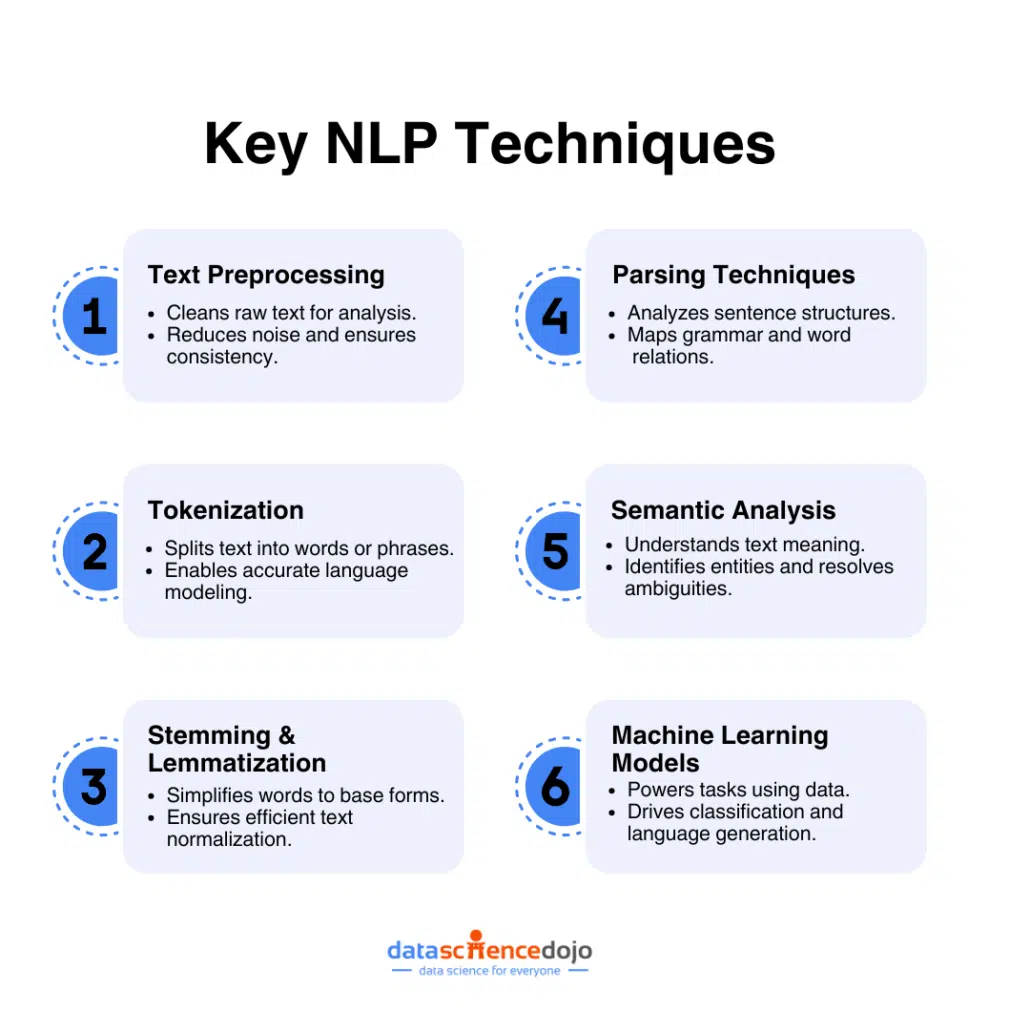
Natural language processing encompasses various techniques that enable computers to process and understand human language efficiently. These techniques are fundamental in transforming raw text data into structured, meaningful information machines can analyze.
Understand 7 NLP Techniques and Tasks to Implement Using Python
By leveraging these methods, NLP systems can perform a wide range of tasks, from basic text classification to complex language generation and understanding. Let’s explore some common techniques used in NLP:
Text Preprocessing
Text preprocessing is a crucial step in NLP, involving several sub-techniques to prepare raw text data for further analysis. This process cleans and organizes the text, making it suitable for machine learning algorithms.
Effective text preprocessing can significantly enhance the performance of NLP models by reducing noise and ensuring consistency in the data.
Tokenization
Tokenization involves breaking down text into smaller units like words or phrases. It is essential for tasks such as text analysis and language modeling. By converting text into tokens, NLP systems can easily manage and manipulate the data, enabling more precise interpretation and processing.
It forms the foundation for many subsequent NLP tasks, such as part-of-speech tagging and named entity recognition.
Learn more about Tokenization in NLP
Stemming
Stemming reduces words to their base or root form. For example, the words “running,” “runner,” and “ran” are transformed to “run.” This technique helps in normalizing words to a common base, facilitating better text analysis and information retrieval.
Although stemming can sometimes produce non-dictionary forms of words, it is computationally efficient and beneficial for various text-processing applications.
Lemmatization
Lemmatization considers the context and converts words to their meaningful base form. For instance, “better” becomes “good.” Unlike stemming, lemmatization ensures that the root word is a valid dictionary word, providing more accurate and contextually appropriate results.
This technique is particularly useful in applications requiring a deeper understanding of language, such as sentiment analysis and machine translation.
Parsing Techniques in NLP
Parsing techniques analyze the grammatical structure of sentences to understand their syntax and relationships between words. These techniques are integral to natural language processing as they enable machines to comprehend the structure and meaning of human language, facilitating more accurate and context-aware interactions.
Some key parsing techniques are:
Syntactic Parsing
Syntactic parsing involves analyzing the structure of sentences according to grammatical rules to form parse trees. These parse trees represent the hierarchical structure of a sentence, showing how different components (such as nouns, verbs, and adjectives) are related to each other.
Syntactic parsing is crucial for tasks that require a deep understanding of sentence structure, such as machine translation and grammatical error correction.
Dependency Parsing
Dependency parsing focuses on identifying the dependencies between words to understand their syntactic structure. Unlike syntactic parsing, which creates a hierarchical tree, dependency parsing forms a dependency graph, where nodes represent words, and edges denote grammatical relationships.
This technique is particularly useful for understanding the roles of words in a sentence and is widely applied in tasks like information extraction and question answering.
Constituency Parsing
Constituency parsing breaks down a sentence into sub-phrases or constituents, such as noun phrases and verb phrases. This technique creates a constituency tree, where each node represents a constituent that can be further divided into smaller constituents.
Constituency parsing helps in identifying the hierarchical structure of sentences and is essential for applications like text summarization and sentiment analysis.
Semantic Analysis
Semantic analysis aims to understand the meaning behind words and phrases in a given context. By interpreting the semantics of language, machines can comprehend the intent and nuances of human communication, leading to more accurate and meaningful interactions.
Named Entity Recognition (NER)
Named Entity Recognition (NER) identifies and classifies entities like names of people, organizations, and locations within text. NER is crucial for extracting structured information from unstructured text, enabling applications such as information retrieval, question answering, and content recommendation.
Word Sense Disambiguation (WSD)
Word Sense Disambiguation determines the intended meaning of a word in a specific context. This technique is essential for tasks like machine translation, where accurate interpretation of word meanings is critical.
WSD enhances the ability of NLP systems to understand and generate contextually appropriate text, improving the overall quality of language processing applications.
Machine Learning Models in NLP
NLP relies heavily on different types of machine learning models for various tasks. These models enable machines to learn from data and perform complex language processing tasks with high accuracy.
Understand the Transformer models: the future of natural language processing
Supervised Learning
Supervised learning models are trained on labeled data, making them effective for tasks like text classification and sentiment analysis. By learning from annotated examples, these models can accurately predict labels for new, unseen data. Supervised learning is widely used in applications such as spam detection, language translation, and speech recognition.
Unsupervised Learning
Unsupervised learning models find patterns in unlabeled data, useful for clustering and topic modeling. These models do not require labeled data and can discover hidden structures within the text. Unsupervised learning is essential for tasks like document clustering, anomaly detection, and recommendation systems.
Deep Learning
Deep learning models, such as neural networks, excel in complex tasks like language generation and translation, thanks to their ability to learn from vast amounts of data. These models can capture intricate patterns and representations in language, enabling advanced NLP applications like chatbots, virtual assistants, and automated content creation.
By employing these advanced text preprocessing, parsing techniques, semantic analysis, and machine learning models, NLP systems can achieve a deeper understanding of human language, leading to more accurate and context-aware applications.
Check out Text Mining Techniques in NLP
Essential NLP Tools and Libraries
Several tools and libraries make it easier to implement NLP tasks, offering a range of functionalities from basic text processing to advanced machine learning and deep learning capabilities. These tools are widely used by researchers and practitioners to develop, train, and deploy natural language processing models efficiently.
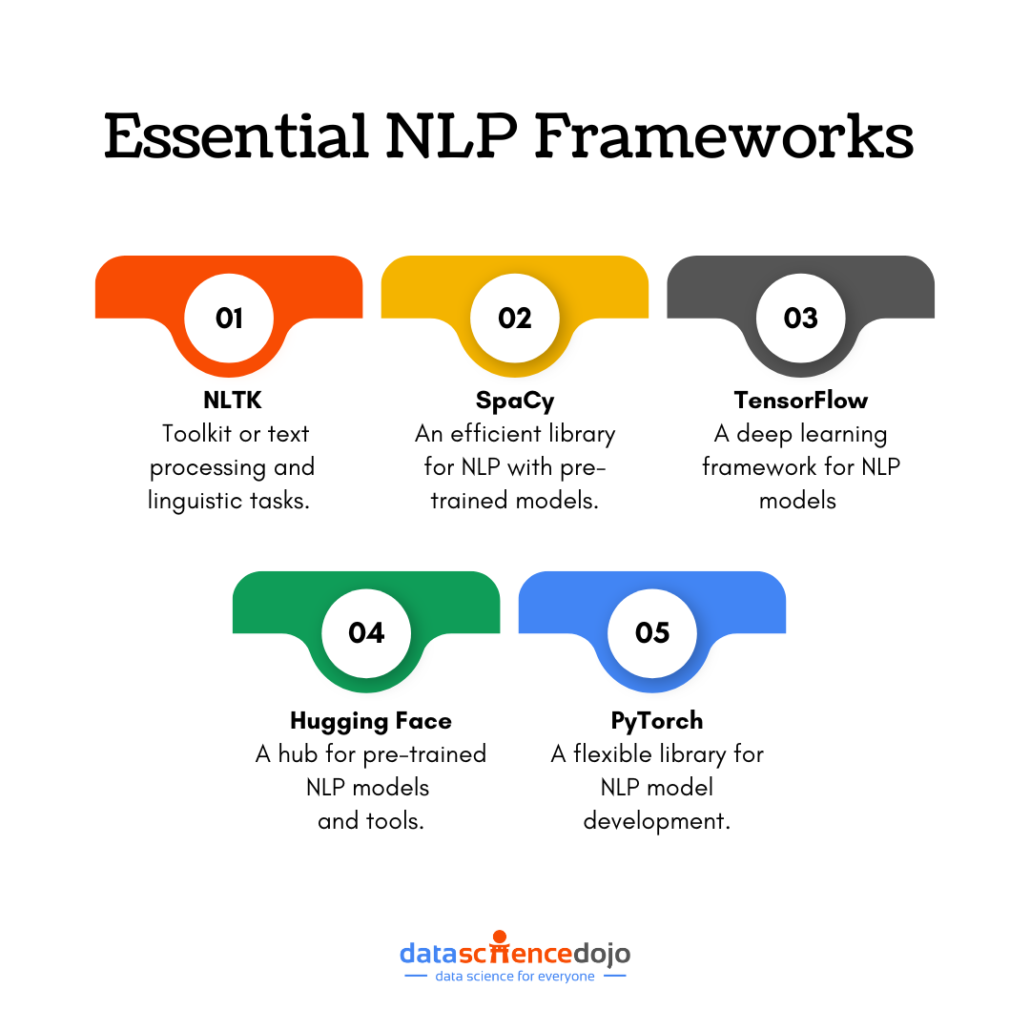
NLTK (Natural Language Toolkit)
NLTK is a comprehensive library in Python for text processing and linguistic data analysis. It provides a rich set of tools and resources, including over 50 corpora and lexical resources such as WordNet. NLTK supports a wide range of NLP tasks, such as tokenization, stemming, lemmatization, part-of-speech tagging, and parsing.
Its extensive documentation and tutorials make it an excellent starting point for beginners in NLP. Additionally, NLTK’s modularity allows users to customize and extend its functionalities according to their specific needs.
SpaCy
SpaCy is a fast and efficient library for advanced NLP tasks like tokenization, POS tagging, and Named Entity Recognition (NER). Designed for production use, spaCy is optimized for performance and can handle large volumes of text quickly.
It provides pre-trained models for various languages, enabling users to perform complex NLP tasks out-of-the-box. SpaCy’s robust API and integration with deep learning frameworks like TensorFlow and PyTorch make it a versatile tool for both research and industry applications. Its easy-to-use syntax and detailed documentation further enhance its appeal to developers.
TensorFlow
TensorFlow is an open-source library for machine learning and deep learning, widely used for building and training NLP models. Developed by Google Brain, TensorFlow offers a flexible ecosystem that supports a wide range of tasks, from simple linear models to complex neural networks.
Its high-level APIs, such as Keras, simplify the process of building and training models, while TensorFlow’s extensive community and resources provide valuable support and learning opportunities. TensorFlow’s capabilities in distributed computing and model deployment make it a robust choice for large-scale NLP projects.
PyTorch
PyTorch is another popular deep-learning library known for its flexibility and ease of use in developing NLP models. Developed by Facebook’s AI Research lab, PyTorch offers dynamic computation graphs, which allow for more intuitive model building and debugging. Its seamless integration with Python and strong support for GPU acceleration enable efficient training of complex models.
PyTorch’s growing ecosystem includes libraries like TorchText and Hugging Face Transformers, which provide additional tools and pre-trained models for NLP tasks. The library’s active community and comprehensive documentation further enhance its usability and adoption.
Hugging Face
Hugging Face offers a vast repository of pre-trained models and tools for NLP, making it easy to deploy state-of-the-art models like BERT and GPT. The Hugging Face Transformers library provides access to a wide range of transformer models, which are pre-trained on massive datasets and can be fine-tuned for specific tasks.
This library supports various frameworks, including TensorFlow and PyTorch, allowing users to leverage the strengths of both. Hugging Face also provides the Datasets library, which offers a collection of ready-to-use datasets for NLP, and the Tokenizers library, which includes fast and efficient tokenization tools.
The Hugging Face community and resources, such as tutorials and model documentation, further facilitate the development and deployment of advanced NLP solutions.
By leveraging these powerful tools and libraries, researchers and developers can efficiently implement and advance their NLP projects, pushing the boundaries of what is possible in natural language understanding and generation. Let’s see how the accuracy of machine learning models can improve through natural language processing.
How Does NLP Improve the Accuracy of Machine Translation?
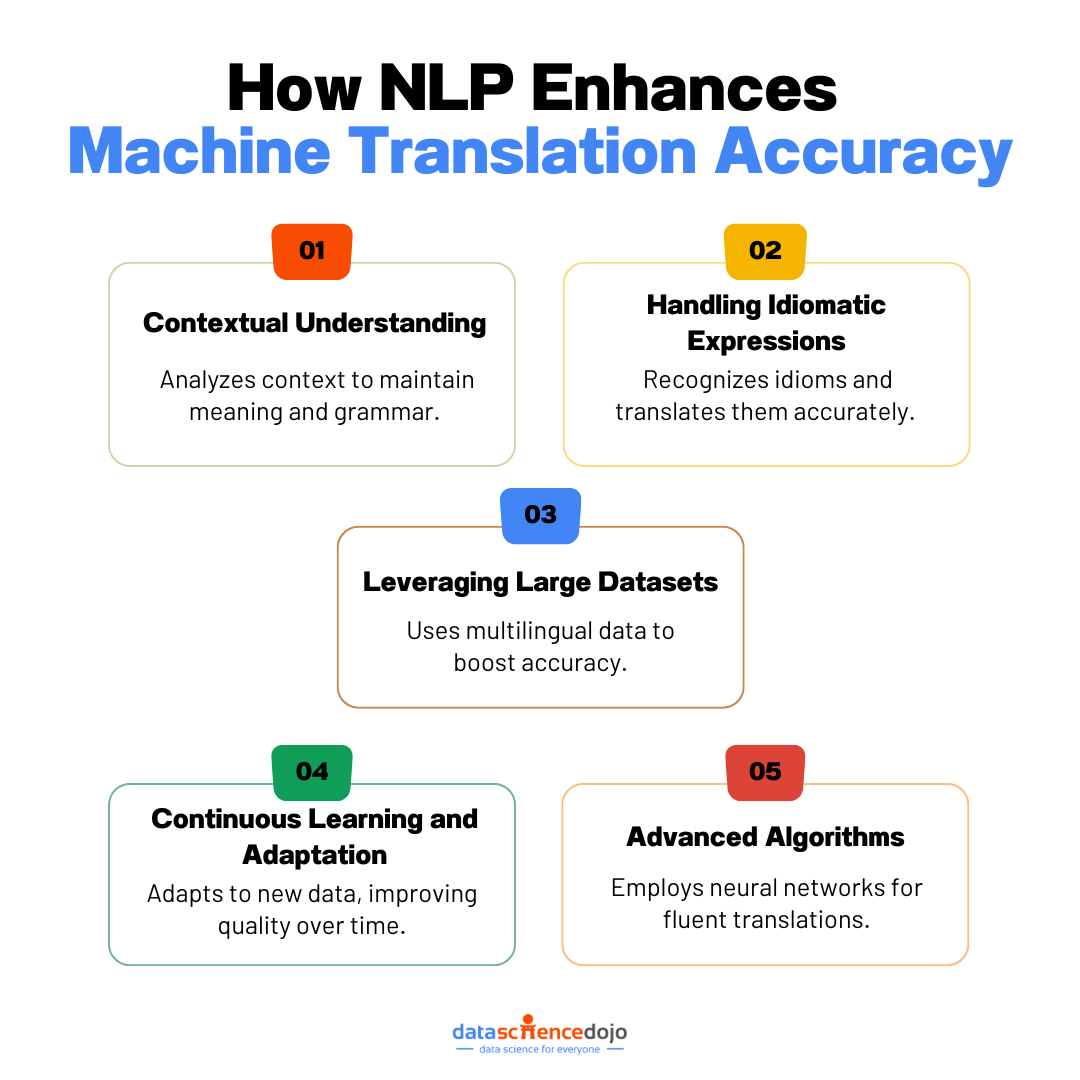
Machine translation has become an essential tool in our globalized world, enabling seamless communication across different languages. It automatically converts text from one language to another, maintaining the context and meaning. Natural language processing (NLP) significantly enhances the accuracy of machine translation by leveraging advanced algorithms and large datasets.
Learn Evaluating large language models (LLMs): Insights about transforming trends
Here’s how natural language processing brings precision and reliability to machine translation:
1. Contextual Understanding
NLP algorithms analyze the context of words within a sentence rather than translating words in isolation. By understanding the context, NLP ensures that the translation maintains the intended meaning, nuance, and grammatical correctness.
For instance, the phrase “cloud computing” translates accurately into other languages, considering “cloud” as a technical term rather than a weather-related phenomenon.
2. Handling Idiomatic Expressions
Languages are filled with idiomatic expressions and phrases that do not translate directly. NLP systems recognize these expressions and translate them into equivalent phrases in the target language, preserving the original meaning.
This capability stems from natural language processing’s ability to understand the semantics behind words and phrases.
3. Leveraging Large Datasets
NLP models are trained on vast amounts of multilingual data, allowing them to learn from numerous examples and improve their translation accuracy. These datasets include parallel corpora, which are collections of texts in different languages that are aligned sentence by sentence.
This extensive training helps natural language processing models understand language nuances and cultural references.
4. Continuous Learning and Adaptation
NLP-powered translation systems continuously learn and adapt to new data. With every translation request, the system refines its understanding and improves its performance.
This continuous learning process ensures that the translation quality keeps improving over time, adapting to new language trends and usage patterns.
Explore Insights about transforming trends in Evaluating large language models
5. Advanced Algorithms
NLP employs sophisticated algorithms such as neural networks and deep learning models, which have proven to be highly effective in language processing tasks. Neural machine translation (NMT) systems, for instance, use encoder-decoder architectures and attention mechanisms to produce more accurate and fluent translations.
These advanced models can handle complex sentence structures and long-range dependencies, which are common in natural language.
NLP significantly enhances the accuracy of machine translation by providing contextual understanding, handling idiomatic expressions, leveraging large datasets, enabling continuous learning, and utilizing advanced algorithms.
These capabilities make NLP-powered machine translation tools like Google Translate reliable and effective for both personal and professional use. Let’s dive into the top applications of natural language processing that are making significant waves across different sectors.
Natural Language Processing Applications

Let’s review some natural language processing applications and understand how NLP decreases our workload and helps us complete many time-consuming tasks more quickly and efficiently. It automatically converts text from one language to another, maintaining the context and meaning.
1. Email Filtering
Email has become an integral part of our daily lives, but the influx of spam can be overwhelming. NLP-powered email filtering systems like those used by Gmail categorize incoming emails into primary, social, promotions, or spam folders, ensuring that important messages are not lost in the clutter.
Natural language processing techniques such as keyword extraction and text classification scan emails automatically, making our inboxes more organized and manageable. Natural language processing identifies and filters incoming emails into “important” or “spam” and places them into their designations.
Read more about 5 useful AI translation tools
2. Language Translation
In our globalized world, the need to communicate across different languages is paramount. NLP helps bridge this gap by translating languages while retaining sentiments and context.
Tools like Google Translate leverage Natural language processing to provide accurate, real-time translations and Speech Recognition that preserve the meaning and convert the spoken language into text while giving the sentiment of the original text. This application is vital for businesses looking to expand their reach and for travelers navigating foreign lands.
3. Smart Assistants
In today’s world, every new day brings in a new smart device, making this world smarter and smarter by the day. And this advancement is not just limited to machines. We have advanced enough technology to have smart assistants, such as Siri, Alexa, and Cortana. We can talk to them like we talk to normal human beings, and they even respond to us in the same way.
All of this is possible because of natural language processing. It helps the computer system understand our language by breaking it into parts of speech, root stem, and other linguistic features. It not only helps them understand the language but also in processing its meaning and sentiments and answering back in the same way humans do. It provides answers to user queries by understanding and processing natural language inputs.
4. Document Analysis
Organizations are inundated with vast amounts of data in the form of documents. Natural language processing simplifies this by automating the analysis and categorization of documents. Whether it’s sorting through job applications, legal documents, or customer feedback, Natural language processing can quickly and accurately process large datasets, aiding in decision-making and improving operational efficiency.
By leveraging natural language processing, companies can reduce manual labor, cut costs, and ensure data consistency across their operations.
Explore more about AI-powered document search
5. Online Searches
In this world full of challenges and puzzles, we must constantly find our way by getting the required information from available sources. One of the most extensive information sources is the internet.
We type what we want to search and checkmate! We have got what we wanted. But have you ever thought about how you get these results even when you do not know the exact keywords you need to search for the needed information? Well, the answer is obvious.
It is again natural language processing. It helps search engines understand what is asked of them by comprehending the literal meaning of words and the intent behind writing that word, hence giving us the results, we want.
6. Predictive Text
A similar application to online searches is predictive text. It is something we use whenever we type anything on our smartphones. Whenever we type a few letters on the screen, the keyboard gives us suggestions about what that word might be and when we have written a few words, it starts suggesting what the next word could be. It also classifies the text and categorizes it into predefined classes, such as spam detection and topic categorization.
Read more about Generative AI for Data Analytics: Top 7 Tools, Use-cases, and More
Still, as time passes, it gets trained according to our texts and starts to suggest the next word correctly even when we have not written a single letter of the next word. All this is done using natural language Processing by making our smartphones intelligent enough to suggest words and learn from our texting habits.
7. Automatic Summarization
With the increasing inventions and innovations, data has also increased. This increase in data has also expanded the scope of data processing. Still, manual data processing is time-consuming and prone to error.
NLP has a solution for that, too, it can not only summarize the meaning of information, but it can also understand the emotional meaning hidden in the information.
Natural language processing models can condense large volumes of text into concise summaries, retaining the essential information. Thus, making the summarization process quick and impeccable. This is particularly useful for professionals who need to stay updated with industry news, research papers, or lengthy reports.
8. Sentiment Analysis
The daily conversations, the posted content and comments, book, restaurant, and product reviews, hence almost all the conversations and texts are full of emotions. Understanding these emotions is as important as understanding the word-to-word meaning.
We as humans can interpret emotional sentiments in writings and conversations, but with the help of natural language processing, computer systems can also understand the sentiments of a text along with its literal meaning.
NLP-powered sentiment analysis tools scan social media posts, reviews, and feedback to classify opinions as positive, negative, or neutral. This enables companies to gauge customer satisfaction, track brand sentiment, and tailor their products or services accordingly.
9. Chatbots
With the increase in technology, everything has been digitalized, from studying to shopping, booking tickets, and customer service. Instead of waiting a long time to get some short and instant answers, the chatbot replies instantly and accurately. Chatbots also help in places where human power is less or is not available around the clock.
Chatbots operating on natural language processing also have emotional intelligence, which helps them understand the customer’s emotional sentiments and respond to them effectively. This has transformed customer service by providing instant, 24/7 support. Powered by NLP, these chatbots can understand and respond to customer queries conversationally.
Learn how to master the creation of a rule-based chatbot in Python
10. Social Media Monitoring
Nowadays, every other person has a social media account where they share their thoughts, likes, dislikes, and experiences. We do not only find information about individuals but also about the products and services. The relevant companies can process this data to get information about their products and services to improve or amend them. With the explosion of social media, monitoring and analyzing user-generated content has become essential.
Natural language processing comes into play here. It enables the computer system to understand unstructured social media data, analyze it, and produce the required results in a valuable form for companies. NLP enables companies to track trends, monitor brand mentions, and analyze consumer behavior on social media platforms.
These were some essential applications of Natural language processing. While we understand the practical applications, we must also have some knowledge of evaluating the NLP models we use. Let’s take a closer look at some key evaluation metrics.
Evaluation Metrics for NLP Models
Evaluating natural language processing models is crucial to ensure their effectiveness and reliability. Different metrics cater to various aspects of model performance, providing a comprehensive assessment. These metrics help identify areas for improvement and guide the optimization of models for better accuracy and efficiency.
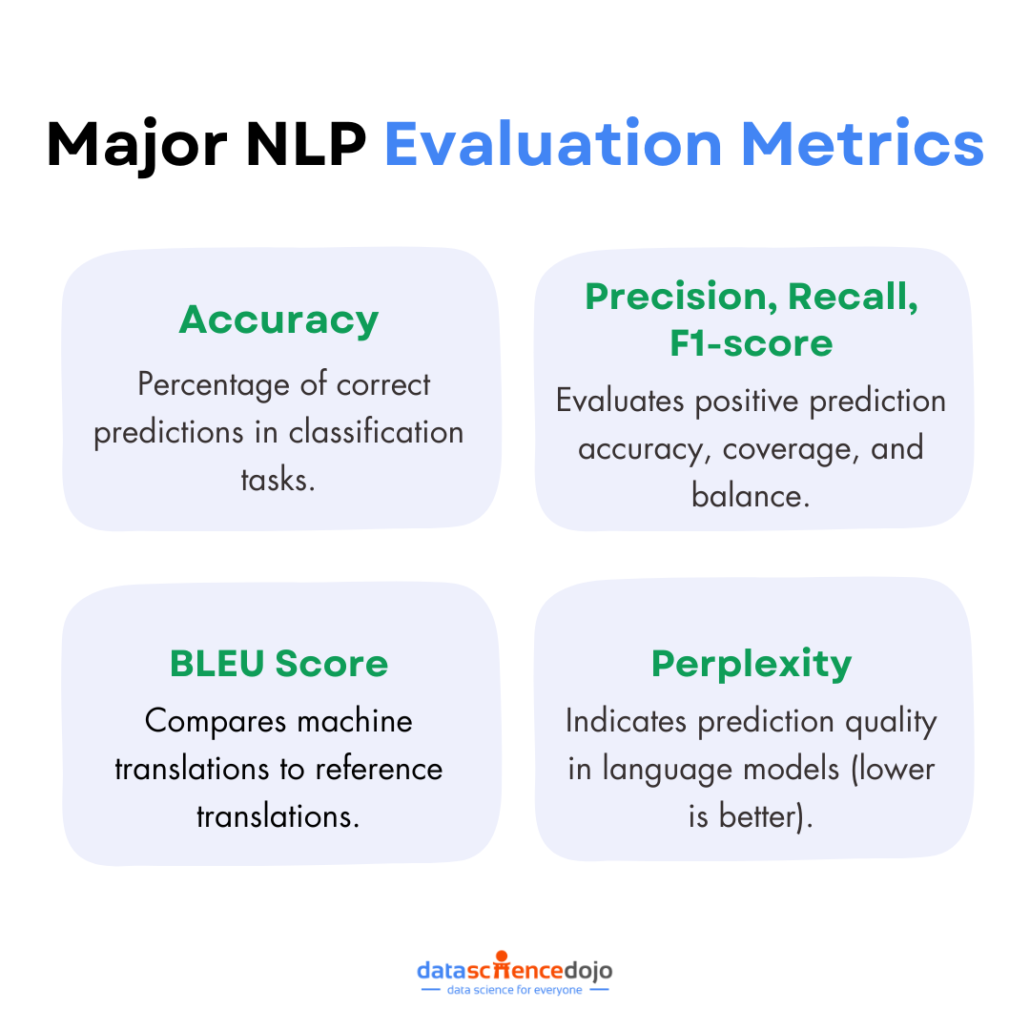
Accuracy
Accuracy is a fundamental metric used to measure the proportion of correct predictions made by an NLP model. It is widely applicable to classification tasks and provides a straightforward assessment of a model’s performance.
However, accuracy alone may not be sufficient, especially in cases of imbalanced datasets where other metrics like precision, recall, and F1-score become essential.
Precision, Recall, and F1-score
Precision, recall, and F1-score are critical metrics for evaluating classification models, particularly in scenarios where class imbalance exists:
Precision: Measures the proportion of true positive predictions among all positive predictions made by the model.
Recall: Evaluate the proportion of true positive predictions among all actual positive instances.
F1-score: The harmonic mean of precision and recall, providing a balance between the two metrics and giving a single score that accounts for both false positives and false negatives.
BLEU Score for Machine Translation
The BLEU (Bilingual Evaluation Understudy) score is a precision-based metric used to evaluate the quality of machine-generated translations by comparing them to one or more reference translations.
It calculates the n-gram precision of the translation, where n-grams are sequences of n words. Despite its limitations, such as sensitivity to word order, the BLEU score remains a widely used metric in machine translation.
Perplexity for Language Models
Perplexity is a metric used to evaluate the fluency and coherence of language models. It measures the likelihood of a given sequence of words under the model, with lower perplexity indicating better performance.
This metric is particularly useful for assessing language models like GPT and BERT, as it considers the probability of word sequences, reflecting the model’s ability to predict the next word in a sequence.
Learn more about LLM evaluation and its metrics
Implementing NLP models effectively requires robust techniques and continuous improvement practices. By addressing the challenges, the effectiveness of NLP models can be enhanced and be ensured that they deliver accurate, fair, and reliable results.
Main Challenges in Natural Language Processing
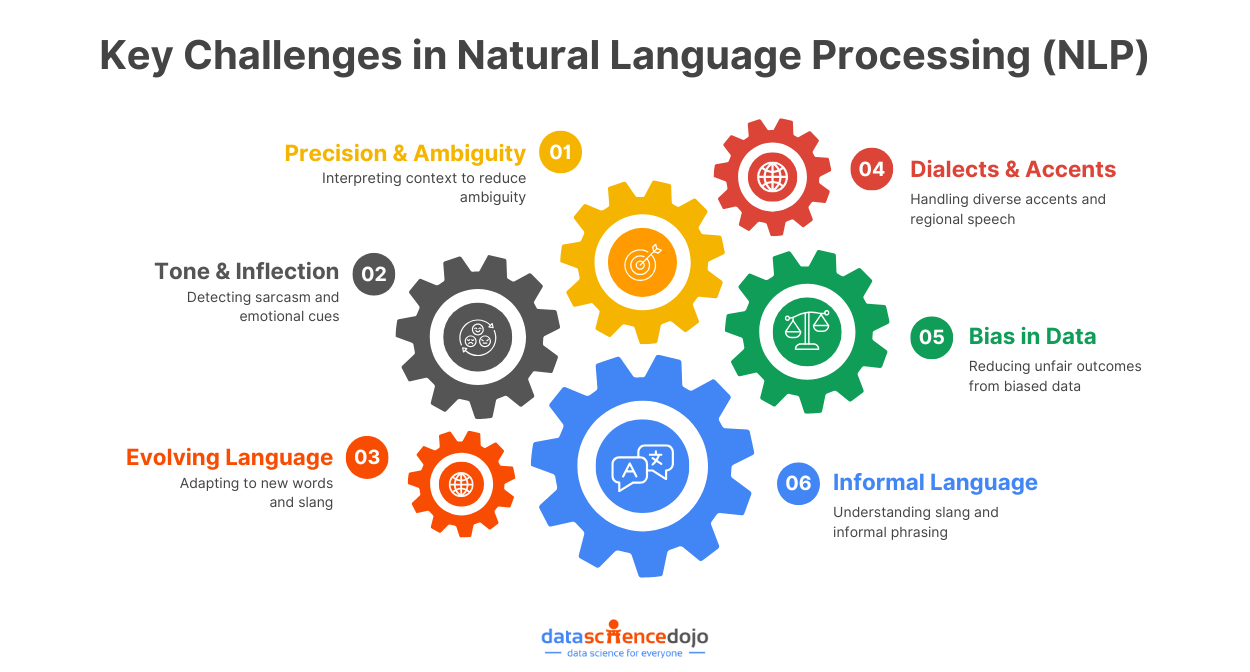
Imagine you’re trying to teach a computer to understand and interpret human language, much like how you’d explain a complex topic to a friend. Now, think about the various nuances, slang, and regional dialects that spice up our conversations. This is precisely the challenge faced by natural language processing (NLP).
While NLP has made significant strides, it still grapples with several key challenges. Some major challenges include:
1. Precision and Ambiguity
Human language is inherently ambiguous and imprecise. Computers traditionally require precise, structured input, but human speech often lacks such clarity. For instance, the same word can have different meanings based on context.
A classic example is the word “bank,” which can refer to a financial institution or the side of a river. Natural language processing systems must accurately discern these meanings to function correctly.
2. Tone of Voice and Inflection
The subtleties of tone and inflection in speech add another layer of complexity. NLP systems struggle to detect sarcasm, irony, or emotional undertones that are evident in human speech.
For example, the phrase “Oh, great!” can be interpreted as genuine enthusiasm or sarcastic displeasure, depending on the speaker’s tone. This makes semantic analysis particularly challenging for natural language processing algorithms.
Learn to build and deploy a semantic search engine using HuggingFace
3. Evolving Use of Language
Language is dynamic and constantly evolving. New words, slang, and phrases emerge regularly, making it difficult for Natural Language Processing systems to stay up-to-date. Traditional computational rules may become obsolete as language usage changes over time.
For example, the term “ghosting” in the context of abruptly cutting off communication in relationships was not widely recognized until recent years.
4. Handling Diverse Dialects and Accents
Different accents and dialects further complicate Natural language processing. The way words are pronounced can vary significantly across regions, making it challenging for speech recognition systems to accurately transcribe spoken language. For instance, the word “car” might sound different when spoken by someone from Boston versus someone from London.
5. Bias in Training Data
Bias in training data is a significant issue in natural language processing. If the data used to train NLP models reflects societal biases, the models will likely perpetuate these biases.
This is particularly concerning in fields like hiring and medical diagnosis, where biased NLP systems can lead to unfair or discriminatory outcomes. Ensuring unbiased and representative training data remains a critical challenge.
6. Misinterpretation of Informal Language
Informal language, including slang, idioms, and colloquialisms, poses another challenge for natural language processing. Such language often deviates from standard grammar and syntax rules, making it difficult for NLP systems to interpret correctly.
For instance, the phrase “spill the tea” means to gossip, which is not immediately apparent from a literal interpretation.
Precision and ambiguity, tone and voice, evolving use of language, handling diverse dialects and accents, bias in training data, and misinterpretation of informal language were some of the major challenges of natural language processing. Let’s delve into the future trends and advancements in the field to see how it is evolving.
Future Trends in NLP
Natural language processing (NLP) is continually evolving, driven by advancements in technology and increased demand for more sophisticated language understanding and generation capabilities. Here are some key future trends in NLP:
Advancements in Deep Learning Models
Deep learning models are at the forefront of NLP advancements. Transformer models, such as BERT, GPT, and their successors, have revolutionized the field with their ability to understand context and generate coherent text.
Future trends include developing more efficient models that require less computational power while maintaining high performance. Research into models that can better handle low-resource languages and fine-tuning techniques to adapt pre-trained models to specific tasks will continue to be a significant focus.
Integration with Multimodal Data
The integration of NLP with multimodal data—such as combining text with images, audio, and video—promises to create more comprehensive and accurate models.
This approach can enhance applications like automated video captioning, sentiment analysis in videos, and more nuanced chatbots that understand both spoken language and visual cues. Multimodal NLP models can provide richer context and improve the accuracy of language understanding and generation tasks.
Real-Time Language Processing
Real-time language processing is becoming increasingly important, especially in applications like virtual assistants, chatbots, and real-time translation services. Future advancements will focus on reducing latency and improving the speed of language models without compromising accuracy.
Techniques such as edge computing and optimized algorithms will play a crucial role in achieving real-time processing capabilities.
Enhanced Contextual Understanding
Understanding context is essential for accurate language processing. Future NLP models will continue to improve their ability to grasp the nuances of language, including idioms, slang, and cultural references.
This enhanced contextual understanding will lead to more accurate translations, better sentiment analysis, and more effective communication between humans and machines. Models will become better at maintaining context over longer conversations and generating more relevant responses.
Resources for Learning NLP
For those interested in diving into the world of NLP, there are numerous resources available to help you get started and advance your knowledge.
Online Courses and Tutorials
Online courses and tutorials offer flexible learning options for beginners and advanced learners alike. Platforms like Coursera, edX, and Udacity provide comprehensive NLP courses covering various topics, from basic text preprocessing to advanced deep learning models.
These courses often include hands-on projects and real-world applications to solidify understanding.
Research Papers and Journals
Staying updated with the latest research is crucial in the fast-evolving field of NLP. Research papers and journals such as the ACL Anthology, arXiv, and IEEE Transactions on Audio, Speech, and Language Processing publish cutting-edge research and advancements in NLP.
Reading these papers helps in understanding current trends, methodologies, and innovative approaches in the field.
Books and Reference Materials
Books and reference materials provide in-depth knowledge and a foundational understanding of NLP concepts. Some recommended books include:
- “Speech and Language Processing” by Daniel Jurafsky and James H. Martin
- “Natural Language Processing with Python” by Steven Bird, Ewan Klein, and Edward Loper
- “Deep Learning for Natural Language Processing” by Palash Goyal, Sumit Pandey, and Karan Jain.
These books cover a wide range of topics and are valuable resources for both beginners and seasoned practitioners.
Community Forums and Discussion Groups
Engaging with the NLP community through forums and discussion groups can provide additional support and insights. Platforms like Reddit, Stack Overflow, and specialized NLP groups on LinkedIn offer opportunities to ask questions, share knowledge, and collaborate with other enthusiasts and professionals.
Participating in these communities can help problem-solve, stay updated with the latest trends, and network with peers. By leveraging these resources, individuals can build a strong foundation in NLP and stay abreast of the latest advancements and best practices in the field.
Explore and join our Large Language Models Bootcamp
For those looking to learn and grow in the field of natural language processing, a wealth of resources is available, from online courses and research papers to books and community forums.
Embracing these trends and resources will enable individuals and organizations to harness the full potential of NLP, driving innovation and improving human-computer interactions.






